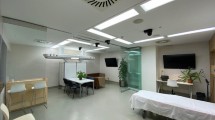Abstract
In this paper, we introduce a simulation study to improve the antineoplastic medication preparation and delivery performance at a pharmacy department in a large community hospital. The goal of this work is to help pharmacy reduce patients’ average waiting time when receiving chemotherapy. This will be achieved by simulating and analyzing the preparation and delivery procedures to identify process bottlenecks, carry out what-if analysis, predict the impact of improvement effort, and provide recommendations to hospital leadership. Using the simulation model, we discover that by introducing early preparation for the returning patients and dedicating an infusion staff member for medication delivery, patients’ waiting time for antineoplastic medications can be reduced substantially. Such improvements do not require additional floor space or significant investment. The recommendation has been accepted by hospital management and implemented in the pharmacy department. The preliminary results have verified the simulation output with the desired improvement predicted by the model.








Similar content being viewed by others
References
Jacobson, S. H., Hall, S. N., and Swisher, J. R., Discrete-event simulation of health care systems. In: Hall, R. W. (Ed.), Patient flow: Reducing delay in healthcare delivery, Vol. 91, pp. 211–252, 2006.
Brenner, S., Zeng, Z., Liu, Y., Wang, J., Li, J., and Howard, P. K., Modeling and analysis of emergency department at University of Kentucky Chandler Hospital using simulations. J. Emerg. Nurs. 36:303–310, 2010.
Reynolds, J., Zeng, Z., Li, J., and Chiang, S.-Y., Design and analysis of a health care clinic for homeless people using simulations, Int. J. Health Care Qual. Assur. 23:607–620, 2010.
Lu, L., Li J., and Gisler, P., Improving financial performance by modeling and analysis of radiology procedure scheduling at a large community hospital. J. Med. Syst. 35:299–307, 2011.
Zeng, Z., Ma, X., Hu, Y., Li, J., and Bryant, D., A simulation study to improve quality of care in emergency department of a community hospital. J. Emerg. Nurs. 2011. doi:10.1016/j.jen.2011.03.005.
Wang, J., Li, J., Tussey, K., and Ross, K., Reducing length of stay in emergency department: A simulation study at a community hospital. IEEE Trans. Syst. Man Cybern., Part A accepted, 2011.
Vemuri, S., Simulated analysis of patient waiting time in an outpatient pharmacy. Am. J. Hosp. Pharm. 41:1127–1130, 1984.
Ishimoto, K., Ishimitsu, T., Koshiro, A., and Hirose, S., Computer simulation of optimum personnel assignment in hospital pharmacy using a work-sampling method. Infor. Health and Soc. Care 15:343–354, 1990.
Lin, A. C., Jang, R., Sedani, D., Thomas, S., Barker, K. N., and Flynn, E. A., Re-engineering a pharmacy work system and layout to facilate patient counceling. Am. J. Health-Syst. Pharm. 53:1558–1564, 1996.
Bryony, D., van Ackere, A., Gallivan, S., and Barber, N., When should pharmacists visit their wards? An application of simulation to planning hospital pharmacy services. Health Care Manage. Sci. 2:35–42, 1999.
Tan, W. S., Chua, S. L. Yong, K. W., and Wu, T. S., Impact of pharmacy automation on patient waiting time: An application of computer simulation. Ann. Acad. Med. 38:501–507, 2009.
Hauge, J. W., and Paige, K. N., Learning SIMUL8: the complete guide. Bethlingham, WA: Plain Vu Publishers, 2002.
Author information
Authors and Affiliations
Corresponding author
Additional information
This paper is supported in part by NSF Grant # CMMI 1063671.
Rights and permissions
About this article
Cite this article
Lu, T., Wang, S., Li, J. et al. A Simulation Study to Improve Performance in the Preparation and Delivery of Antineoplastic Medications at a Community Hospital. J Med Syst 36, 3083–3089 (2012). https://doi.org/10.1007/s10916-011-9786-y
Received:
Accepted:
Published:
Issue Date:
DOI: https://doi.org/10.1007/s10916-011-9786-y




